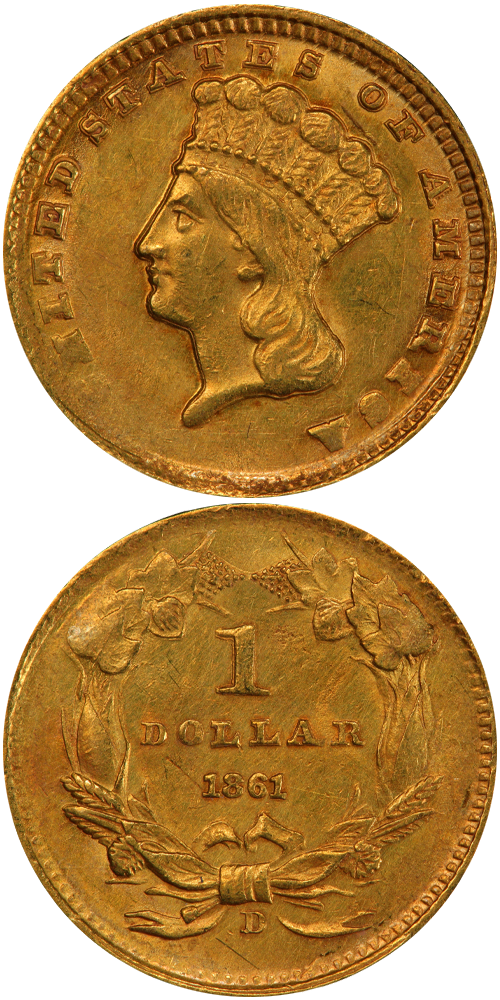1861-D Gold Dollar
Outside of the virtually-uncollectible 1849-C Open Wreath, the 1861-D is the undeniable star of the gold dollar series, and perhaps one of the most intriguing issues to ever emerge from the Dahlonega Mint. By the brink of the 1860s the American political climate was in a state of chaotic volatility. Outraged over Lincoln's victorious presidential campaign, the legislature of South Carolina voted to secede from the Union on December 20, 1860, initiating what would be a furious cascade of secessions over the following months. Amidst this tumultuous atmosphere, two pairs of gold dollar dies were sent from Philadelphia down to Dahlonega in December of 1860, arriving on January 7th, 1861 in anticipation of a full production year. However, this would be the last time dies would cross the Mason-Dixon en route to Dahlonega, as Georgia would sign the Ordinance of Secession just twelve days later, becoming the fifth state to secede from the Union. The Mint itself was occupied by rebel troops on April 8th, leading director George Kellogg to relinquish the facility to Confederate operation soon thereafter.
Despite a vacuum of knowledge and skills relevant to the minting process, in May of 1861 the Confederacy utilized the remaining bullion on hand to strike approximately $3,000 face value worth of coinage divided between gold dollars and half eagles. A small quantity of half eagles had been produced at Dahlonega prior to Confederate occupation, though the gold dollars struck by rebel technicians represent the only examples to be struck of the issue. This gives the 1861-D gold dollar the distinction of being the only coin to be struck exclusively by the Confederacy, as the 1861-O half dollar and 1861-C half eagles both have Federal analogues.
Overall production quality was dreadful. Despite the supposed availability of fresh dies from Philadelphia, an obverse die was reemployed from the previous year. The inadequacies of the fatigued die were only exasperated by the novice minters, provoking a profound weakness to the lower obverse peripheries on all pieces, with the U of UNITED completely obliterated at times. While the reverse is typically more presentable, it too is plagued by peripheral softness that obscures the denticulation on many examples
The Dahlonega Mint was soon after converted to an assay office by the Confederate Congress on August 24, 1861, and went on to be used for academic purposes in the following decades, though it never again struck even a single coin. As the Civil War's numismatic bastard child, the 1861-D gold dollar is truly one of the most significant issues to come from an American mint.
Scholars traditionally estimate that approximately 1,000 to 1,500 gold dollars were struck, with more modern research by Carl Lester suggesting an even lower number of 500 pieces, according to assay records. Of that figure, just 50 to 60 pieces are thought to exist today. Curiously, this extant population is largely composed of well-preserved pieces, with a particular concentration to be seen in Choice About Uncirculated grades. This suggests that they were perhaps saved as souvenirs, or points towards the existence of a small hoard, though in true Mint State this issue is a fabled treasure.
The example to the left was sold by Stack's Bowers Galleries in the November 2016 Baltimore Auction, where it realized $76,375.






